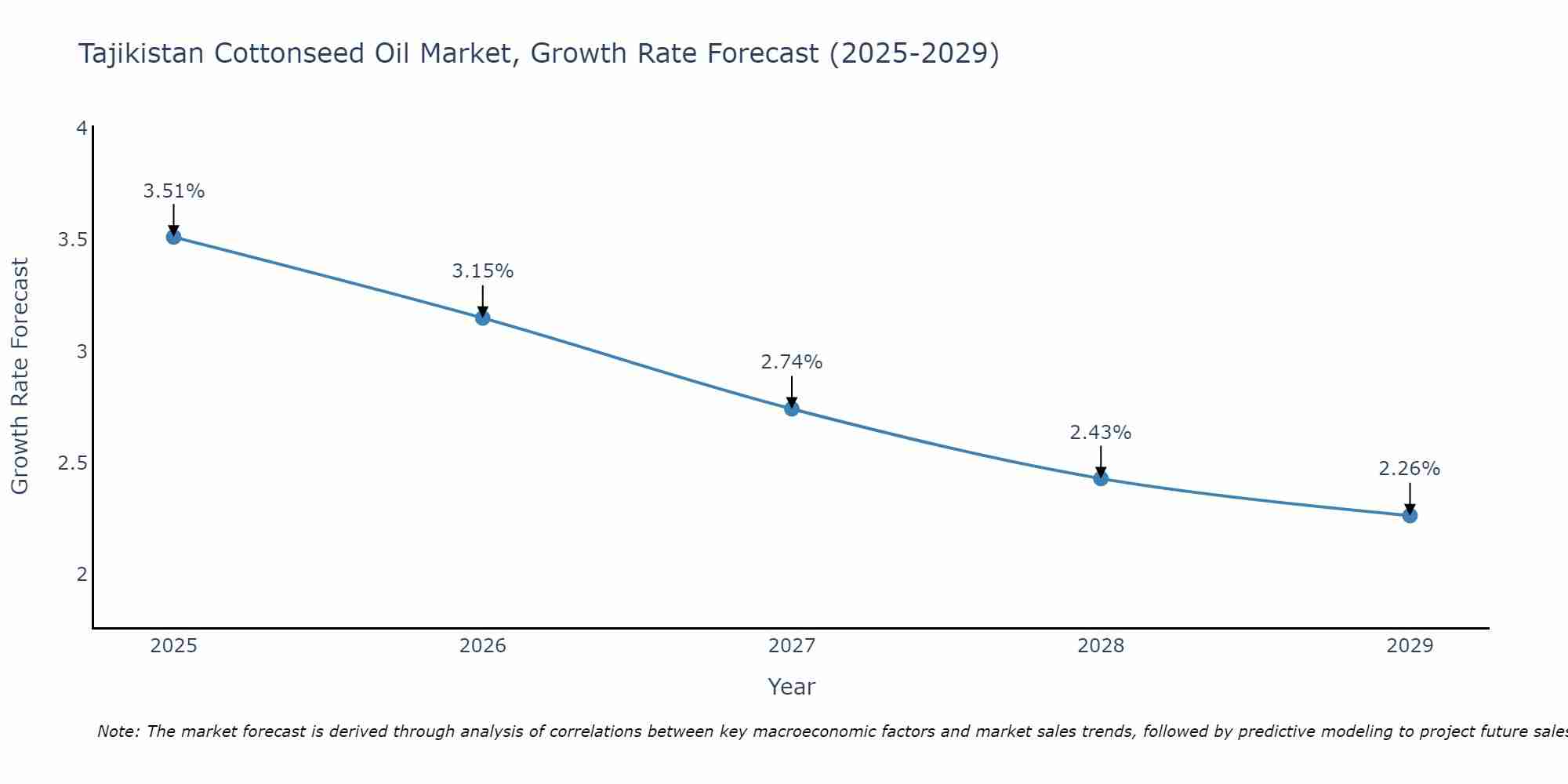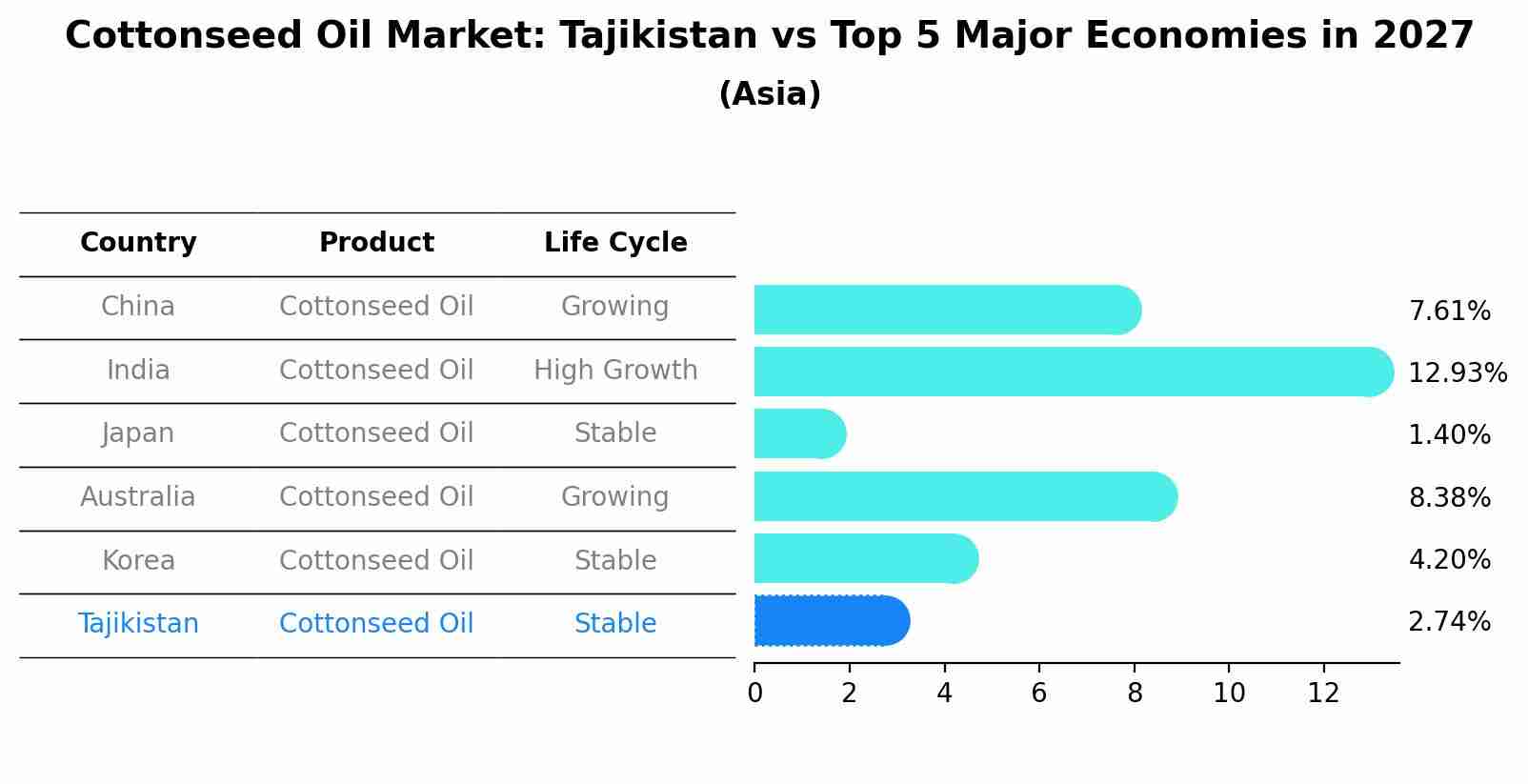Tajikistan Cottonseed Oil Market (2025-2031) Outlook | Analysis, Revenue, Industry, Forecast, Value, Size, Growth, Companies, Trends & Share
| Product Code: ETC082998 | Publication Date: Jun 2021 | Updated Date: Jun 2025 | Product Type: Report | |
| Publisher: 6Wresearch | Author: Dhaval Chaurasia | No. of Pages: 70 | No. of Figures: 35 | No. of Tables: 5 |
Tajikistan Cottonseed Oil Market Size Growth Rate
The Tajikistan Cottonseed Oil Market may undergo a gradual slowdown in growth rates between 2025 and 2029. Although the growth rate starts strong at 3.51% in 2025, it steadily loses momentum, ending at 2.26% by 2029.

Cottonseed Oil Market: Tajikistan vs Top 5 Major Economies in 2027 (Asia)
By 2027, Tajikistan's Cottonseed Oil market is forecasted to achieve a stable growth rate of 2.74%, with China leading the Asia region, followed by India, Japan, Australia and South Korea.

Tajikistan Cottonseed Oil Market Overview
The Tajikistan Cottonseed Oil Market is characterized by a growing demand for edible oils due to the increasing population and changing dietary habits. Cottonseed oil is a popular choice among consumers in Tajikistan for its affordability and versatility in cooking applications. The market is primarily dominated by domestic production, with local companies playing a significant role in meeting the country`s demand. However, imports also contribute to the market, especially during periods of high demand. The market is expected to witness steady growth in the coming years, driven by factors such as rising disposable incomes and a focus on healthier cooking oils. Key players in the Tajikistan Cottonseed Oil Market include both local manufacturers and international brands looking to capitalize on the growing consumer interest in healthier food options.
Tajikistan Cottonseed Oil Market Trends
The Tajikistan Cottonseed Oil Market is witnessing several key trends. Firstly, there is a growing demand for cottonseed oil due to its perceived health benefits and versatile culinary uses. Consumers are increasingly choosing cottonseed oil over other types of cooking oils such as sunflower or soybean oil. Secondly, there is a focus on sustainable and organic cottonseed oil production methods, driven by increasing consumer awareness of environmental issues and a preference for natural products. Additionally, there is a trend towards product innovation, with manufacturers introducing new varieties of cottonseed oil infused with different flavors or enriched with nutrients. Overall, the Tajikistan Cottonseed Oil Market is experiencing growth and diversification driven by changing consumer preferences and an emphasis on quality and sustainability.
Tajikistan Cottonseed Oil Market Challenges
In the Tajikistan Cottonseed Oil Market, challenges include limited domestic production capacity leading to a reliance on imports, fluctuating global prices impacting pricing and profit margins, lack of modern technology and infrastructure for efficient processing, and competition from other vegetable oils. Additionally, inefficient supply chain logistics and inadequate storage facilities contribute to supply chain disruptions and product quality issues. Regulatory barriers and bureaucratic hurdles also hinder market growth and investment. Addressing these challenges will require strategic investments in technology and infrastructure, improvements in supply chain management, and policy reforms to promote domestic production and enhance competitiveness in the global market.
Tajikistan Cottonseed Oil Market Investment Opportunities
In the Tajikistan Cottonseed Oil Market, there are several investment opportunities worth considering. With a growing demand for edible oils in the region, investing in cottonseed oil production facilities or partnering with existing local manufacturers could be lucrative. Additionally, there is potential for vertical integration by investing in cotton farming operations to ensure a stable supply of raw materials. Developing value-added products such as organic or cold-pressed cottonseed oil could also cater to the niche market segment. Furthermore, exploring export opportunities to neighboring countries in Central Asia could provide a broader market reach and increase profitability. Overall, investing in the Tajikistan Cottonseed Oil Market offers potential for growth and diversification within the agricultural sector.
Tajikistan Cottonseed Oil Market Government Policy
In Tajikistan, the government plays a significant role in the cottonseed oil market through various policies. The government provides subsidies and support to cotton farmers to ensure a steady supply of cottonseeds for oil production. Additionally, there are regulations in place to promote local processing of cottonseeds into oil, aiming to boost domestic production and reduce reliance on imports. The government also monitors and controls the quality standards of cottonseed oil to ensure consumer safety and promote a competitive market environment. Overall, government policies in Tajikistan focus on supporting the local cottonseed oil market, enhancing self-sufficiency, and maintaining quality standards to meet both domestic demand and potential export opportunities.
Tajikistan Cottonseed Oil Market Future Outlook
The Tajikistan Cottonseed Oil Market is expected to witness steady growth in the coming years due to increasing demand for edible oils, particularly those considered healthier options. As consumers become more health-conscious and seek out alternatives to traditional oils, cottonseed oil is gaining popularity for its high smoke point and neutral flavor. Additionally, the government`s support for the agricultural sector and initiatives to improve cotton production efficiency will likely boost cottonseed oil availability. However, factors such as fluctuating cotton prices, competition from other vegetable oils, and global market dynamics could influence the market`s growth trajectory. Overall, the Tajikistan Cottonseed Oil Market is projected to expand gradually, driven by evolving consumer preferences and supportive agricultural policies.
Key Highlights of the Report:
- Tajikistan Cottonseed Oil Market Outlook
- Market Size of Tajikistan Cottonseed Oil Market, 2021
- Forecast of Tajikistan Cottonseed Oil Market, 2031
- Historical Data and Forecast of Tajikistan Cottonseed Oil Revenues & Volume for the Period 2021 - 2031
- Tajikistan Cottonseed Oil Market Trend Evolution
- Tajikistan Cottonseed Oil Market Drivers and Challenges
- Tajikistan Cottonseed Oil Price Trends
- Tajikistan Cottonseed Oil Porter's Five Forces
- Tajikistan Cottonseed Oil Industry Life Cycle
- Historical Data and Forecast of Tajikistan Cottonseed Oil Market Revenues & Volume By Raw Material for the Period 2021 - 2031
- Historical Data and Forecast of Tajikistan Cottonseed Oil Market Revenues & Volume By Genetically Modified Cotton for the Period 2021 - 2031
- Historical Data and Forecast of Tajikistan Cottonseed Oil Market Revenues & Volume By Non-GM Cotton for the Period 2021 - 2031
- Historical Data and Forecast of Tajikistan Cottonseed Oil Market Revenues & Volume By End-Users for the Period 2021 - 2031
- Historical Data and Forecast of Tajikistan Cottonseed Oil Market Revenues & Volume By Retail for the Period 2021 - 2031
- Historical Data and Forecast of Tajikistan Cottonseed Oil Market Revenues & Volume By Food Processing for the Period 2021 - 2031
- Historical Data and Forecast of Tajikistan Cottonseed Oil Market Revenues & Volume By Cosmetics for the Period 2021 - 2031
- Historical Data and Forecast of Tajikistan Cottonseed Oil Market Revenues & Volume By Other Applications for the Period 2021 - 2031
- Tajikistan Cottonseed Oil Import Export Trade Statistics
- Market Opportunity Assessment By Raw Material
- Market Opportunity Assessment By End-Users
- Tajikistan Cottonseed Oil Top Companies Market Share
- Tajikistan Cottonseed Oil Competitive Benchmarking By Technical and Operational Parameters
- Tajikistan Cottonseed Oil Company Profiles
- Tajikistan Cottonseed Oil Key Strategic Recommendations
Frequently Asked Questions About the Market Study (FAQs):
1 Executive Summary |
2 Introduction |
2.1 Key Highlights of the Report |
2.2 Report Description |
2.3 Market Scope & Segmentation |
2.4 Research Methodology |
2.5 Assumptions |
3 Tajikistan Cottonseed Oil Market Overview |
3.1 Tajikistan Country Macro Economic Indicators |
3.2 Tajikistan Cottonseed Oil Market Revenues & Volume, 2021 & 2031F |
3.3 Tajikistan Cottonseed Oil Market - Industry Life Cycle |
3.4 Tajikistan Cottonseed Oil Market - Porter's Five Forces |
3.5 Tajikistan Cottonseed Oil Market Revenues & Volume Share, By Raw Material, 2021 & 2031F |
3.6 Tajikistan Cottonseed Oil Market Revenues & Volume Share, By End-Users, 2021 & 2031F |
4 Tajikistan Cottonseed Oil Market Dynamics |
4.1 Impact Analysis |
4.2 Market Drivers |
4.3 Market Restraints |
5 Tajikistan Cottonseed Oil Market Trends |
6 Tajikistan Cottonseed Oil Market, By Types |
6.1 Tajikistan Cottonseed Oil Market, By Raw Material |
6.1.1 Overview and Analysis |
6.1.2 Tajikistan Cottonseed Oil Market Revenues & Volume, By Raw Material, 2018 - 2027F |
6.1.3 Tajikistan Cottonseed Oil Market Revenues & Volume, By Genetically Modified Cotton , 2018 - 2027F |
6.1.4 Tajikistan Cottonseed Oil Market Revenues & Volume, By Non-GM Cotton, 2018 - 2027F |
6.2 Tajikistan Cottonseed Oil Market, By End-Users |
6.2.1 Overview and Analysis |
6.2.2 Tajikistan Cottonseed Oil Market Revenues & Volume, By Retail, 2018 - 2027F |
6.2.3 Tajikistan Cottonseed Oil Market Revenues & Volume, By Food Processing, 2018 - 2027F |
6.2.4 Tajikistan Cottonseed Oil Market Revenues & Volume, By Cosmetics, 2018 - 2027F |
6.2.5 Tajikistan Cottonseed Oil Market Revenues & Volume, By Other Applications, 2018 - 2027F |
7 Tajikistan Cottonseed Oil Market Import-Export Trade Statistics |
7.1 Tajikistan Cottonseed Oil Market Export to Major Countries |
7.2 Tajikistan Cottonseed Oil Market Imports from Major Countries |
8 Tajikistan Cottonseed Oil Market Key Performance Indicators |
9 Tajikistan Cottonseed Oil Market - Opportunity Assessment |
9.1 Tajikistan Cottonseed Oil Market Opportunity Assessment, By Raw Material, 2021 & 2031F |
9.2 Tajikistan Cottonseed Oil Market Opportunity Assessment, By End-Users, 2021 & 2031F |
10 Tajikistan Cottonseed Oil Market - Competitive Landscape |
10.1 Tajikistan Cottonseed Oil Market Revenue Share, By Companies, 2021 |
10.2 Tajikistan Cottonseed Oil Market Competitive Benchmarking, By Operating and Technical Parameters |
11 Company Profiles |
12 Recommendations |
13 Disclaimer |
- Single User License$ 1,995
- Department License$ 2,400
- Site License$ 3,120
- Global License$ 3,795
Search
Thought Leadership and Analyst Meet
Our Clients
Related Reports
- Afghanistan Apparel Market (2026-2032) | Growth, Outlook, Industry, Segmentation, Forecast, Size, Companies, Trends, Value, Share, Analysis & Revenue
- Canada Oil and Gas Market (2026-2032) | Share, Segmentation, Value, Industry, Trends, Forecast, Analysis, Size & Revenue, Growth, Competitive Landscape, Outlook, Companies
- Germany Breakfast Food Market (2026-2032) | Industry, Share, Growth, Size, Companies, Value, Analysis, Revenue, Trends, Forecast & Outlook
- Australia Briquette Market (2025-2031) | Growth, Size, Revenue, Forecast, Analysis, Trends, Value, Share, Industry & Companies
- Vietnam System Integrator Market (2025-2031) | Size, Companies, Analysis, Industry, Value, Forecast, Growth, Trends, Revenue & Share
- ASEAN and Thailand Brain Health Supplements Market (2025-2031) | Strategy, Consumer Insights, Analysis, Investment Trends, Opportunities, Growth, Size, Share, Industry, Revenue, Segments, Value, Segmentation, Supply, Forecast, Restraints, Outlook, Competition, Drivers, Trends, Demand, Pricing Analysis, Competitive, Strategic Insights, Companies, Challenges
- ASEAN Bearings Market (2025-2031) | Strategy, Consumer Insights, Analysis, Investment Trends, Opportunities, Growth, Size, Share, Industry, Revenue, Segments, Value, Segmentation, Supply, Forecast, Restraints, Outlook, Competition, Drivers, Trends, Demand, Pricing Analysis, Competitive, Strategic Insights, Companies, Challenges
- Europe Flooring Market (2025-2031) | Outlook, Share, Industry, Trends, Forecast, Companies, Revenue, Size, Analysis, Growth & Value
- Saudi Arabia Manlift Market (2025-2031) | Outlook, Size, Growth, Trends, Companies, Industry, Revenue, Value, Share, Forecast & Analysis
- Uganda Excavator, Crane, and Wheel Loaders Market (2025-2031) | Strategy, Consumer Insights, Analysis, Investment Trends, Opportunities, Growth, Size, Share, Industry, Revenue, Segments, Value, Segmentation, Supply, Forecast, Restraints, Outlook, Competition, Drivers, Trends, Demand, Pricing Analysis, Competitive, Strategic Insights, Companies, Challenges
Industry Events and Analyst Meet
Whitepaper
- Middle East & Africa Commercial Security Market Click here to view more.
- Middle East & Africa Fire Safety Systems & Equipment Market Click here to view more.
- GCC Drone Market Click here to view more.
- Middle East Lighting Fixture Market Click here to view more.
- GCC Physical & Perimeter Security Market Click here to view more.
6WResearch In News
- Doha a strategic location for EV manufacturing hub: IPA Qatar
- Demand for luxury TVs surging in the GCC, says Samsung
- Empowering Growth: The Thriving Journey of Bangladesh’s Cable Industry
- Demand for luxury TVs surging in the GCC, says Samsung
- Video call with a traditional healer? Once unthinkable, it’s now common in South Africa
- Intelligent Buildings To Smooth GCC’s Path To Net Zero


















